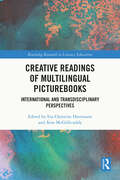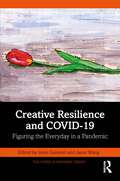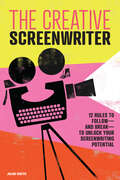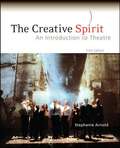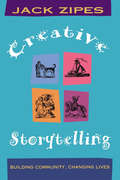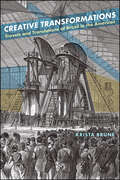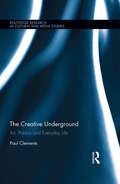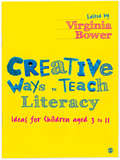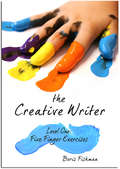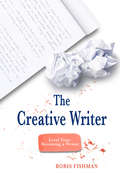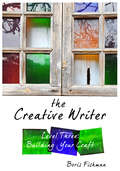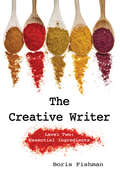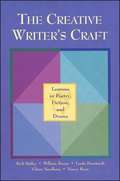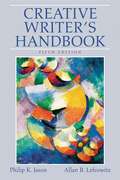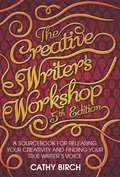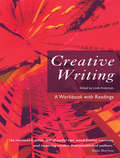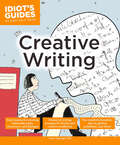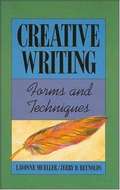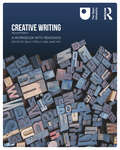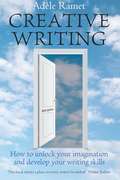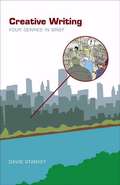- Table View
- List View
Creative Readings of Multilingual Picturebooks: International and Transdisciplinary Perspectives (Routledge Research in Literacy Education)
by Esa Christine Hartmann Áine McGillicuddyThis edited volume offers fresh perspectives on linguistic and cultural diversity in multilingual picturebooks, examining their potential to support multilingual learning in different educational contexts. Drawing on international, transdisciplinary perspectives from over fifteen countries, the book provides a comprehensive view of this unique literary genre.The collection showcases a wide range of languages featured in multilingual picturebooks, including Chinese, Farsi, Georgian, Irish, Korean, Malagasy, Mexican Indigenous languages, Mirandese, Northern Sámi, Portuguese, Spanish, Te Reo Māori, Ukrainian, and Welsh. Various chapters examine how multilingual picturebooks foster language and literacy development for emergent bilinguals in multilingual and multicultural environments, highlighting benefits such as linguistic and semiotic code-switching, as well as their ability to stimulate intercultural awareness in readers. The book also considers the creation, translation, and complex publishing processes of multilingual picturebooks, while exploring modern technologies such as eye tracking to analyse the reading processes of these books.Reflecting current insights and innovations in picturebook research, this volume will appeal to scholars, academics, and researchers in language and literacy education, multilingual education, and early childhood education. Those involved in children’s literature studies, multimodality, and bilingualism more broadly will also find this collection valuable.
Creative Resilience and COVID-19: Figuring the Everyday in a Pandemic (The COVID-19 Pandemic Series)
by Irene GammelCreative Resilience and COVID-19 examines arts, culture, and everyday life as a way of navigating through and past COVID-19. Drawing together the voices of international experts and emerging scholars, this volume explores themes of creativity and resilience in relation to the crisis, trauma, cultural alterity, and social change wrought by the pandemic. The cultural, social, and political concerns that have arisen due to COVID-19 are inextricably intertwined with the ways the pandemic has been discussed, represented, and visualized in global media. The essays included in this volume are concerned with how artists, writers, and advocates uncover the hope, plasticity, and empowerment evident in periods of worldwide loss and struggle—factors which are critical to both overcoming the COVID-19 pandemic and fashioning the post-COVID-19 era. Elaborating on concepts of the everyday and the outbreak narrative, Creative Resilience and COVID-19 explores diverse themes including coping with the crisis through digital distractions, diary writing, and sounds; the unequal vulnerabilities of gender, ethnicity, and age; the role of visuality and creativity including comics and community theatre; and the hopeful vision for the future through urban placemaking, nighttime sociability, and cinema. The book fills an important scholarly gap, providing foundational knowledge from the frontlines of the COVID-19 pandemic through a consideration of the arts, humanities, and social sciences. In doing so, Creative Resilience and COVID-19 expands non-medical COVID-19 studies at the intersection of media and communication studies, cultural criticism, and the pandemic.
The Creative Screenwriter: 12 Rules to Follow—and Break—to Unlock Your Screenwriting Potential
by Julian HoxterMaster the craft of screenwriting—12 steps to bring your creative vision to the screen It can be difficult to find a modern resource that teaches you the nuts and bolts of screenwriting while also allowing you the freedom to creatively thrive. This guide distills the craft of screenwriting into 12 key elements, from developing your story to revising and rewriting, plus plenty of inspiration to create your own screenplay with confidence. Discover what to expect within the film industry and how it has evolved. Look behind the scenes at iconic films using a classic structure of screenwriting, along with experimental films from innovative writers that have transcended the rules and paved their own way to the silver screen. Then, get to the exciting part—writing—using a dozen tried-and-true rules of the trade. Each chapter is accompanied with an In the Writer's Room creative exercise, such as formatting your script, mapping sequences, and creating rich dialogue and characters, to deepen your understanding of what brings a screenplay to life. This screenwriting guide includes: Filmmaker's dozen—From loglines to creating a compelling character to root for, you'll find 12 fundamental but flexible steps to help you craft a powerful, creative screenplay. Topline terminology—Navigate the film biz like a pro with need-to-know Hollywood jargon, plus troubleshooting tips for any screenwriting hiccups along the way. Film archive—From William Goldman's The Princess Bride to Taika Waititi's Jojo Rabbit, discover emerging and timeless screenwriting techniques used in Hollywood blockbusters, micro-budget films, and more. Take your story from creative conception to complete script with this modern, 12-step approach to screenwriting.
Creative Shakespeare: The Globe Education Guide to Practical Shakespeare
by Fiona BanksThis unique book desribes the ways in which educational practitioners at Shakespeare's Globe theatre bring Shakespeare to life for students of all ages.The Globe approach is always active and inclusive - each student finds their own way into Shakespeare - focusing on speaking, moving and performing rather than reading. <p><p>Drawing on her rich and varied experience as a teacher, Fiona Banks offers a range of examples and practical ideas teachers can take and adapt for their own lessons. The result is a stimulating and inspiring book for teachers of drama and English keen to enliven and enrich their students' experience of Shakespeare.
The Creative Spirit: An Introduction to Theatre
by Stephanie ArnoldIncludes discussion of each playwright's other works, sources, timelines for historical and cultural context, and the production of the plays.
The Creative Spirit: An Introduction to Theatre
by Stephanie ArnoldFocusing on the collaborative and creative processes that go into productions, The Creative Spirit: An Introduction to Theatre introduces students to the theatre through the plays themselves and the people who write them, create them, and act in them. The book provides a rich context for each play with a discussion of the playwright's other works, sources for the play, timelines that present historical and cultural background, and a section on a particular production of the play to give students a sense of the theatre industry at close hand. The Creative Spirit includes complete scripts of five plays: August Wilson's Joe Turner's Come and Gone, Wakako Yamauchi's And the Soul Shall Dance, Tony Kushner's Angels in America, Milcha Sanchez-Scott's Dog Lady, and Nilo Cruz's Anna in the Tropics.
Creative Storytelling: Building Community/Changing Lives
by Jack ZipesJack Zipes has reinvigorated storytelling as a successful and engaging tool for teachers and professional storytellers. Encouraging storytellers, librarians, and schoolteachers to be active in this magical process, Zipes proposes an interactive storytelling that creates and strengthens a sense of community for students, teachers and parents while extolling storytelling as animation, subversion, and self-discovery.
Creative Transformations: Travels and Translations of Brazil in the Americas (SUNY series in Latin American and Iberian Thought and Culture)
by Krista BruneIn Creative Transformations, Krista Brune brings together Brazilian fiction, film, journalism, essays, and correspondence from the late nineteenth to the early twenty-first centuries. Drawing attention to the travels of Brazilian artists and intellectuals to the United States and other parts of the Americas, Brune argues that experiences of displacement have had a significant influence on their work. Across Brazilian literary and cultural history, translation becomes a way of navigating and representing the resulting encounters between languages, interactions with Spanish Americans, and negotiations of complex identities. While Creative Transformations engages extensively with theories of translation from different national and disciplinary contexts, it also constructs a vision of translation uniquely attuned to the place of Brazil in the Americas. Brune reveals the hemispheric underpinnings of works by renowned Brazilian writers such as Machado de Assis, Sousândrade, Mário de Andrade, Silviano Santiago, and Adriana Lisboa. In the process, she rethinks the dynamics between cosmopolitan and national desires and between center and periphery in global literary markets.
The Creative Underground: Art, Politics and Everyday Life (Routledge Research in Cultural and Media Studies)
by Paul ClementsPaul Clements champions the creative underground and expressions of difference through visionary avant-garde and resistant ideas. This is represented by an admixture of utopian literature, manifestos and lifestyles which challenge normality and attempt to reinvent society, as practiced for example, by radicals in bohemian enclaves or youth subcultures. He showcases a range of 'art' and participatory cultural practices that are examined sociopolitically and historically, employing key theoretical ideas which highlight their contribution to aesthetic thinking, political ideology, and public discourse. A reevaluation of the arts and progressive modernism can reinvigorate culture through active leisure and post-work possibilities beyond materialism and its constraints, thereby presenting alternatives to established understandings and everyday cultural processes. The book teases out the difficult relationship between the individual, culture and society especially in relation to autonomy and marginality, while arguing that the creative underground is crucial for a better world, as it offers enchantment, vitality and hope.
Creative Ways to Teach Literacy: Ideas for Children aged 3 to 11
by Virginia BowerShortlisted for the UKLA Academic Book Award 2013! Covering the essential areas of practice, this book suggests ways to make your literacy teaching as creative and engaging as possible. Children get the most out of their learning when it is exciting, and this book offers great ideas for classroom practice, whilst making careful links to research. Sections advise on teaching narrative, poetry and non-fiction, and each chapter contains case studies and ideas to try out in practice. The authors cover a broad range of topics, including: - exploring traditional tales - writing from experience - using playground games as a foundation for literacy - performing poetry. Written for teachers working with children aged 3-11 years, this book gives you the opportunity to develop children's literacy in enjoyable and interesting ways.
The Creative Writer: Five Finger Exercises (The Creative Writer)
by Boris FishmanA gentle, imaginative introduction to the skills all creative writers need. Breaking down the elements that go into successful imaginative works, The Creative Writer leads aspiring writers through the skills needed to construct each. The assignments, designed to make students more aware of language and more confident in their own ingenuity, build on each other until beginning creative writers have successfully created their own stories, poems, and essays. * Simple but innovative exercises encourage young writers to strengthen their vocabulary and become aware of the patterns of sentences * Legends and folklore are used to teach point of view, characterization, plotting, and other vital skills * Classic poetry serves as a model for the student's own original poems * Unlike most "how to write" books, The Creative Writer is designed to be used in a mentor/student relationship, with teaching, guidance, and evaluation tips provided for the mentor or teacher * Can be used as a complement to Writing With Skill or on its own
The Creative Writer, Level Four (The Creative Writer)
by Boris FishmanThe culminating volume in the four-book series that guides students into the creation of sophisticated short fiction and mature poetry. Building on the skills taught in the first three levels, The Creative Writer, Level Four: Becoming a Writer guides young writers from idea to polished short story or poem in a single volume. Becoming a Writer also walks students through the transition from study to practice, broadening the series' focus by discussing the writing life -- how to find and submit to literary journals, how to develop discipline, and how to persevere in the face of rejection. Reviews and strengthens the writer's grasp on the five essentials of fiction: plot, character, dialogue, point of view, and setting. Guides the writer into the effective, sophisticated use of the essentials of poetry: sound, rhythm, word choice, and structure. All exercises build toward the production of mature, finished creative piece Can be used as a complement to Writing With Skill or on its own.
The Creative Writer, Level Three: Building Your Craft (The Creative Writer)
by Boris FishmanThe third volume of the four-book series that guides students into the creation of sophisticated short fiction and mature poetry. * Complements Peace Hill Press's expository series Writing With Skill by providing the imaginative element that many students want. * Unlike most "how to write" books, these are designed to be used in a mentor/student relationship, with teaching, guidance, and evaluation tips provided for the mentor or teacher. * All exercises build towards the production of finished creative pieces * Sequential, logical, step-by-step instruction * The third level builds on the introductory volume, The Creative Writer: Five Finger Exercises, but can be started directly by older students. * Instruction in the five essentials of fiction: plot, characters, dialogue, point of view, and setting. Level Three leads students into the construction of more complex plots, evocative settings, and three-dimensional characters * Guidance in the essential art of poetry: sound, rhythm, word choice, and poem construction. Level Three draws students into even more sophisticated use of words and themes.
The Creative Writer, Level Two: Essential Ingredients (The Creative Writer)
by Boris FishmanThe second volume of the four-book series that guides students into the creation of sophisticated short fiction and mature poetry. Complements Peace Hill Press's expository series Writing With Skill by providing the imaginative element that many students want. Unlike most "how to write" books, these are designed to be used in a mentor/student relationship, with teaching, guidance, and evaluation tips provided for the mentor or teacher. All exercises build towards the production of finished creative pieces. Sequential, logical, step-by-step instruction. The second level builds on the introductory volume, The Creative Writer: Five Finger Exercises, but can be started directly by older students. Instruction in the five essentials of fiction: plot, characters, dialogue, point of view, and setting. Offers guidance in the essential art of poetry: sound, rhythm, word choice, and poem construction.
The Creative Writer's Craft: Lessons in Poetry, Fiction, and Drama
by Richard Bailey Mcgraw-Hill StaffThe Creative Writer's Craft is organized by genre into three sections - Poetry, Fiction, and Drama. It offers students the opportunity to explore and develop crafting skills for writing various types of poems, short stories, and one act plays. The lessons and writing activities encourage students to develop a writer's attitude, embracing the writing process rather than the final result.
Creative Writer's Handbook (5th Edition)
by Philip K. Jason Allan B. LefcowitzThis handbook is the perfect reference for beginning creative writers. It offers abundant illustrations, exercises, and useful techniques in all genres. While emphasizing problem-solving and the mastery of literary conventions, this handbook also takes the apprentice writer on a journey from inspiration to revision.
The Creative Writer's Workshop, 5th Edition: A Sourcebook for Releasing Your Creativity and Finding Your True Writer's Voice
by Cathy BirchThis book aims to get you writing and keep you writing - and help you enjoy your writing to the full. It will show you how to free your own unique voice and create original, individual work. It is packed with exercises, visualisation techniques, flow charts, dream-work and word webs that will enable you to explore the treasures of your subconscious, revisit your childhood world of games and make believe, and bring back what you find. Then it shows you how to harness that creativity in developing your characters, settings, plot and dialogue. Additional exercises focus on sustaining your own motivation, providing the perfect setting in which to develop your writing. This book will help you at every stage. Use it to rediscover your love of words and the spontaneity in your writing. Find your voice and become the writer you were meant to be.Contents: 1. Writing as a Way of Life; 2. Tuning In; 3. Discovering the Plot; 4. Developing Atmosphere, Pace and Mood; 5. Working with Beginnings and Endings; 6. Surprise Yourself; 7. Working With Your Dreams; 8. Recycling; 9. Crafting Your Work; 10. Editing Your Work; Glossary; References; Further reading; Useful addresses and websites; Index.
The Creative Writer's Workshop, 5th Edition: A Sourcebook For Releasing Your Creativity And Finding Your True Writer's Voice
by Cathy BirchThis book aims to get you writing and keep you writing - and help you enjoy your writing to the full. It will show you how to free your own unique voice and create original, individual work. It is packed with exercises, visualisation techniques, flow charts, dream-work and word webs that will enable you to explore the treasures of your subconscious, revisit your childhood world of games and make believe, and bring back what you find. Then it shows you how to harness that creativity in developing your characters, settings, plot and dialogue. Additional exercises focus on sustaining your own motivation, providing the perfect setting in which to develop your writing. This book will help you at every stage. Use it to rediscover your love of words and the spontaneity in your writing. Find your voice and become the writer you were meant to be.Contents: 1. Writing as a Way of Life; 2. Tuning In; 3. Discovering the Plot; 4. Developing Atmosphere, Pace and Mood; 5. Working with Beginnings and Endings; 6. Surprise Yourself; 7. Working With Your Dreams; 8. Recycling; 9. Crafting Your Work; 10. Editing Your Work; Glossary; References; Further reading; Useful addresses and websites; Index.
Creative Writing: A Workbook with Readings
by Linda AndersonCreative Writing is a complete writing course that will jump-start your writing and guide you through your first steps towards publication. Suitable for use by students, tutors, writers’ groups or writers working alone, this book offers: a practical and inspiring section on the creative process, showing you how to stimulate your creativity and use your memory and experience in inventive ways in-depth coverage of the most popular forms of writing, in extended sections on fiction, poetry and life writing, including biography and autobiography, giving you practice in all three forms so that you might discover and develop your particular strengths a sensible, up-to-date guide to going public, to help you to edit your work to a professional standard and to identify and approach suitable publishers a distinctive collection of exciting exercises, spread throughout the workbook to spark your imagination and increase your technical flexibility and control a substantial array of illuminating readings, bringing together extracts from contemporary and classic writings in order to demonstrate a range of techniques that you can use or adapt in your own work. Creative Writing: A Workbook with Readings presents a unique opportunity to benefit from the advice and experience of a team of published authors who have also taught successful writing courses at a wide range of institutions, helping large numbers of new writers to develop their talents as well as their abilities to evaluate and polish their work to professional standards. These institutions include Lancaster University and the University of East Anglia, renowned as consistent producers of published writers.
Creative Writing (Idiot's Guides)
by Casey ClaboughCreative writing is arguably the ultimate form of self-expression. Ideal for anyone interested in writing (student or not), Idiot's Guides: Creative Writing helps readers master the basics of crafting compelling fiction and nonfiction stories. Various genres, including novels, short stories, plays and screenplays, poetry, book-length and article-length narrative nonfiction, memoirs, and more are covered. Content includes the fundamental elements, such as plot, character, point-of-view, setting, dialogue, style, and theme. And readers will be able to hone their writing skills and boost their creativity with writing prompts and exercises.
Creative Writing
by Lavonne Mueller Jerry D. Reynolds'Creative Writing' takes writers through all the steps--from keeping a writer's journal to submitting manuscripts for publication. In an exciting format featuring numerous examples from student and professional writing, 'Creative Writing' presents techniques and tips for writing poetry, fiction, drama, and journalism.
Creative Writing: A Workbook with Readings
by Sally O’Reilly Jane YehCreative Writing: A Workbook with Readings provides a complete creative writing course: from ways to jump-start your writing and inspire your creativity, right through to presenting your work to agents and publishers. It covers the genres of fiction, poetry and life writing (including autobiography, biography and travel writing), combining discussions of technique with readings and exercises to guide you step by step towards becoming more adept at creative writing. The second edition has been updated and in large part newly written, with readings by a diverse group of contemporary authors displaying a variety of styles and approaches. Each chapter also features an array of inspiring writing exercises, enabling you to experiment with different methods and discover your strengths. Above all, Creative Writing: A Workbook with Readings will help you to develop your abilities while nurturing your individual voice as a writer.
Creative Writing
by Adèle RametThis book is a first-rate guide for writers who are looking for ways to improve their output. It focuses on: - Fiction writing and the world of genre fiction - science, romance, horror and crime. - Ways of drawing on personal experience in order to write non-fiction articles on a wide variety of topics in a number of different styles. - Writing for children which requires specialist skills that, once mastered, bring enormous satisfaction to both the writer and the reader. - The impact of the internet on the creative writer and the opportunities it presents. Crucially, there is also a chapter on presenting your work to a publisher and getting it into print.
Creative Writing
by Adèle RametThis book is a first-rate guide for writers who are looking for ways to improve their output. It focuses on: - Fiction writing and the world of genre fiction - science, romance, horror and crime. - Ways of drawing on personal experience in order to write non-fiction articles on a wide variety of topics in a number of different styles. - Writing for children which requires specialist skills that, once mastered, bring enormous satisfaction to both the writer and the reader. - The impact of the internet on the creative writer and the opportunities it presents. Crucially, there is also a chapter on presenting your work to a publisher and getting it into print.
Creative Writing: Four Genres in Brief
by David StarkeyHow can students with widely varied levels of literary experience learn to write poetry, fiction, creative nonfiction, and drama -- over the course of only one semester? In Creative Writing: Four Genres in Brief, David Starkey offers some solutions to the challenges of teaching the introductory creative writing course: (1) concise, accessible instruction in literary basics; (2) short models of literature to analyze, admire and emulate; (3) inventive and imaginative assignments that inspire and motivate.
